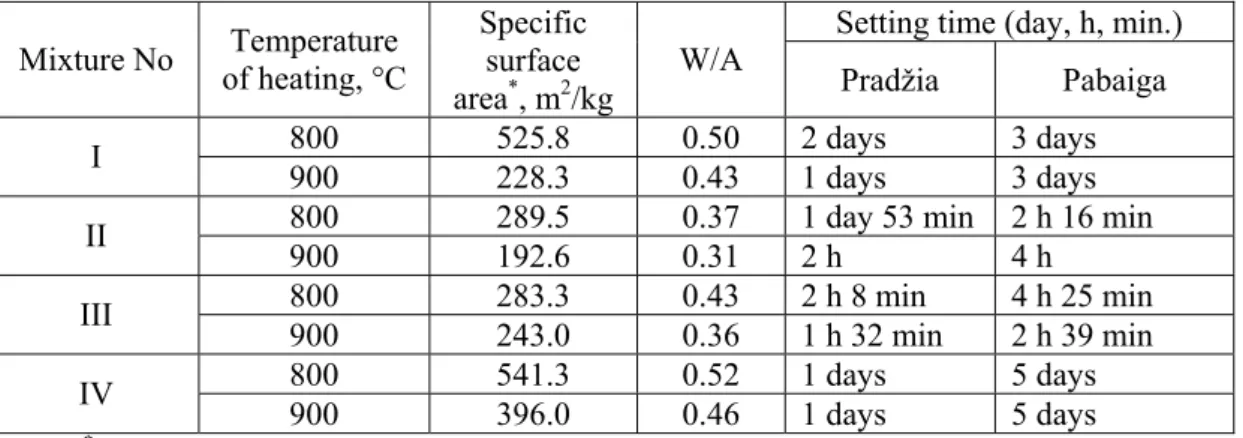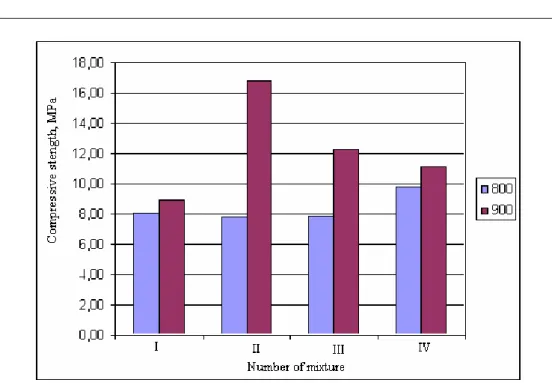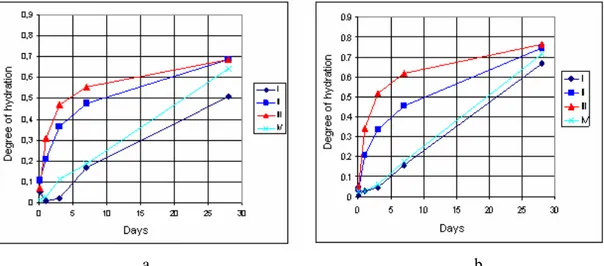_____________________________
*) Corresponding author: dalia.nizeviciene@ktu.lt
doi: 10.2298/SOS1002233L
UDK 621.742:621.89.099:622.785
Influence of the Gypsum Dehydration Temperature and Alkali
Additives on the Properties of Anhydrite Cement
V. Leskeviciene, I. Sarlauskaite, D. Nizeviciene
*), N. Kybartiene
Kaunas University of Technology, Radvilenu 19, LT
─
50270 Kaunas, Lithuania
Abstract:
While dehydrating gypsum with additives at the temperatures of 800 °C and 900 °C the influence of alkali additives on both the crystalline structure of anhydrite and properties of anhydrite binder was investigated. The industrial and household wastes including other low-cost materials were used as additives. Having heated them with gypsum the anhydrite with alkali activation properties was obtained. The properties of such substances were evaluated using the methods of chemical, diffractive X-ray scanning and scanning electron microscopy (SEM) analyses. Some additives, e.g. 5 % ground glass waste, were found to increase crystal agglomerate formation of anhydrite binder, accelerate the hydration process of anhydrite and double the compressive strength of hydrated samples compared to samples without additives.
Keywords: Anhydrite cement, Additive, Dehydration, Compressive strength, Setting time.
1. Introduction
Anhydrite is a widespread mineral in southern and south-western Lithuania. The superposition of anhydrite is closest to the ground (at a depth of 150 to 350 metres) in the eastern part of Lithuania [1]. The average thickness of the layer is 30 to 40 m in these areas, amounting about 350 billion tones of resources. Anhydrite is a unique rock. There is no need to burn it in order to obtain binding properties. Anhydrite binder is obtained having the rock ground finely with additives [2, 3, 4].
Anhydrite binder is widely used in the industry of construction and building materials worldwide. It is used as the floor levelling layer, for plastering, decorative panels. Shredded anhydrite is common in construction of roads, as the filling material – in production of concrete and mortar. In order to regulate the cement binding duration, natural gypsum may be replaced with anhydrite [5, 6].
Synthetic anhydrite is obtained when gypsum is dehydrated at the temperature of 600 to 800ºC [7]. There is little knowledge about the influence of the dehydration temperature on the physical and mechanical properties of anhydrite binder. The most studied anhydrite was obtained from the waste generated in the chemical industry, e. g. nitrogypsum, phosphogypsum, heated at the temperature of 600 to 1000 °C [8, 9].
Pure anhydrite binder sets slowly. The hydraulic activity of anhydrite depends on its crystalline structure and structural defects. Breaking the Ca2+ ion coordination in the calcium sulphate crystalline grating is necessary to accelerate the setting process of the anhydrite binder. This is achieved by fine grinding or by using different activators [2]. The mechanism how the activators work is not completely understood. The activators are believed to act as catalysts to form unstable salts that accelerate the crystallization and hardening of gypsum. A number of studies investigated anhydrite binders with activators added; however their impact on the morphology and properties of anhydrite crystals formed during gypsum dehydration is unknown.
The aim of this work: to determine the influence of alkali additives on the morphology of anhydrite crystals and on the properties of anhydrite binder dehydrating the reagent gypsum together with the additives at the temperatures of 800 and 900 °C.
2. Experimental
Used materials: Reagent gypsum CaSO4·2H2O (Lach-Ner, Czech Republic, purity ─ 99 %). Specific surface (Sspec) ─ 638 m2/kg, pH ─ 8.28, when ratio of water and solid material (W/S) ─ 10. The SEM photograph of crystalline structure is showed in Fig. 1.
Both household and industrial wastes and other low-cost materials were selected as additives. The anhydrite with alkali activator properties may be obtained if the additives were heated together with gypsum at the temperatures of 800 and 900 °C The level of additives (5 %) was optimal in earlier research when phosphogypsum was heated together with the same additives. Additives used:
1) Ground glass (household waste – the fragments of green bottle glass), the grain size < 0.2 mm. An average chemical composition in percentage: SiO2 – 71.07; Na2O – 13.69; K2O – 1.08; Al2O3 – 1.75; CaO – 7.50; Fe2O3 – 0.39; MgO – 4.12; Cr2O3 – 0.20; SO3 – 0.20. Sspec ─ 459 m2/kg, pH = 10.20–10.30, when W/S ─ 10. The curve of X-ray diffraction analysis of the glass (Fig. 2) shows that it has amorphous structure.
Fig.2. X-ray diffraction analysis of the ground glass
2) JSC „Paroc“ (Lithuania) low-furnace dust (industrial waste of rock wool production), particle size < 0.2 mm, Sspec ─ 2434 m2/kg; pH was 9.1–9.2, when W/S ─ 10. The curve of X-ray diffraction analysis of low-furnace dust (Fig. 3) shows that they contain a lot of crystalline cristabolite. The dust also contains lisetite, anorthite, vaterite, illite and magnetite. An average chemical composition in percentage: SiO2 – 41.6; CaO – 3.92; MgO – 13.7; R2O3 –22.0; Na2O – 7.56; K2O – 5.78; others – 2.24; loss of ignition – 3.2.
0 100 200 300 400 500 600 700 800
5 15 25 35 45 55 65
2Θ [deg]
R e la ti v e i n te n s ity [ a .u .] I I V A V LA Q M Q MLA Q
3) Clay from Kruna locality. An average chemical composition in percentage: SiO2 – 56.95; Al2O3 – 15.11; Fe2O3 – 5.50; CaO – 5.00; MgO – 4.30; Na2O –1.34; K2O – 0.70; others – 0.34, loss of ignition – 10. Sspec – 602 m2/kg, pH was 8.2 – 8.3, when W/S – 10.
The X-ray differential analysis curve (Fig. 4) shows that the clay consists of the following minerals: muscovite, feldspars, kaolinite, quartz, calcite, dolomite.
Fig. 4. X-ray diffraction analysis of the clay. Indexes: M – muscovite, K – kaolinite, I – illite, C – calcite, E – microcline, Q – quartz, D – dolomite
Used methods
The X-ray diffraction analysis of the substances was performed using the X-ray diffractometer DRON-6. CuKα radiation and Ni filter were used.
The chemical composition was determined using classical methods of the chemical analysis.
The scanning electron microscopy (SEM) of the materials was performed using FEI QUANTA 200F microscope.
The hydration water in gypsum (loss of ignition, %) was calculated after heating the material at the temperature 400 °C.
The hydration of the anhydrite binder was impeded at some selected time intervals (after 2 hours; after 1, 7, 28 days). The hydration was impeded by grinding the substance in the porcelain mortar, adding acetone, by filtration and drying at 50 °C.
In order to estimate the compressive strength of anhydrite cement, cubes 2×2×2 cm size samples were formed up. The water rate and the setting time of formed mixture (normal consistence) were determined according to standard LST EN 196-3-2005. The samples were hardened in 90 % relative humidity environment for 28 days and compressed by press ELE Automat.
The specific surface area of the substances was determined by the air flow method using device PSCH-4.
The compounds of the gypsum and additives (composition is shown in Tab. I) were heated in porcelain plates 30 min at the temperatures of 800 and 900 °C. The anhydrite was not ground after heating.
Tab. I. Composition of mixtures
Content of components, % Mixture No
gypsum ground glass low furnace dust clay
I 100 - - - II 95 5 - - III 95 - 5 - IV 95 - - 5
3. Results and discussion
The X-ray diffraction analysis of the substances heated with and without additives at the temperatures of 800 and 900 °C allowed concluding that anhydrite (0.34995, 0.28497, 0.23278, 0.22088, 0.18684 nm) prevailed in all products (Fig. 5). The pH value (12.2) of the anhydrite (Tab. II) identified when heating gypsum without additives shows that a small part of CaSO4 split to form CaO during the heating process. CaO should act as an alkaline activator during the hydration of anhydrite.
Tab. II. Characteristic properties of the anhydrite cement
Setting time (day, h, min.) Mixture No Temperature
of heating, °C
Specific surface area*, m2/kg
W/A
Pradžia Pabaiga
800 525.8 0.50 2 days 3 days
I
900 228.3 0.43 1 days 3 days
800 289.5 0.37 1 day 53 min 2 h 16 min
II
900 192.6 0.31 2 h 4 h
800 283.3 0.43 2 h 8 min 4 h 25 min
III
900 243.0 0.36 1 h 32 min 2 h 39 min
800 541.3 0.52 1 days 5 days
IV
900 396.0 0.46 1 days 5 days
Note: * unground anhydrite
In order to explain the effect of the heating temperature on the properties of the anhydrite the studies of the microstructure of the material were carried out. The crystalline structure of materials is very different in SEM photographs.
The crystals of anhydrite formed by heating gypsum without additives at 800 °C (Fig. 6a) were of initial structure of dihydrate calcium sulphate crystal of irregular prism (Fig. 1). Their surface is crannied. It is possible to predict that the evaporation of the crystallization water evoked the formation of the microcracks in the crystal structure of investigated material. As for the crystals of the anhydrite heated at 900 °C – they were smooth without microcracks and formed large agglomerates (Fig. 6b).
800 °C has W/S equal to 0.50. The setting time of materials heated at 900 °C was shorter (Tab. II), and the compressive strength increased (Fig. 7).
Fig.5. X-ray diffraction analysis of the anhydrite obtained at 900 °C: I – without admixtures; II, III, IV ─ with 5 % admixtures: I – ground glass; II – low-furnace dust; III – clay. Index: A – anhydrite (CaSO4)
a b
Fig.6. SEM microphotographs of the anhydrite obtained after having heated gypsum without
Fig. 7. The influence of the additives and heating temperature (800 and 900 °C) on the compressive strength of samples after 28 days of hardening
SEM microphotographs show different forms and sizes of the crystals of the anhydrite formed by heating gypsum with additives. Smaller crystals of the binder were obtained when gypsum heated with ground glass additive at the temperature of 800 °C (Fig. 8a). Its specific surface was larger (289.5 m2/kg) than another sample obtained at 900 °C. The crystals of the latter anhydrite formed agglomerates (Fig. 8b), their specific surface (192.6 m2/kg) and its setting time were reduced. Least water was used (W/S ─ 0.31) to form the samples of the latter anhydrite. Furthermore, the compressive strength (Fig. 7) of the anhydrite binder obtained at 900 °C was twice as strong as of the sample formed using the anhydrite binder obtained at 800 °C.
a b
Fig. 8. SEM microphotographs of the anhydrite obtained after having heated the gypsum with ground glass additive at the temperatures of 800 (a) and 900 °C (b)
found using the low-furnace dust additive compared to the substance with glass additive. The crystals of the material heated at 900 °C form agglomerates (Fig. 9b), its specific surface was lesser (Sspec─ 243.0 m2/kg) compared to the material heated at 800 °C (Sspec─ 283.2 m2/kg) (Fig. 9a). The compressive strength was 1.5 times higher (Fig. 7). However more water was needed to form the samples using the anhydrite with the low-furnace dust additive (W/S = 0.43; 0.36), its strength properties were poorer than that of samples with the glass additive. The setting time was much shorter than that of the anhydrite without additives. The dust was extremely small (Sspec. ─ 2434 m2/kg) so that minor impact of temperature on the crystalline structures and pH values was observed when heating the gypsum with dust additive.
a b
Fig. 9. SEM microphotographs of the anhydrite obtained after having heated the gypsum with low-furnace dust additive at the temperatures of 800 (a) and 900 °C (b); different magnification
a b
Fig. 10. SEM microphotographs of the anhydrite obtained after having heated the gypsum
binder with clay were smaller with more specific surface. The crystalline agglomerates are not formed. The samples distinguished by better strength properties compared to the samples formed from the anhydrite without additives, although more water was needed for the latter (W/S ─ 0.52; 0.46). The setting time was shorter. During heating the gypsum with clay additive the dehydration of both the gypsum and clay minerals takes place, including decarbonisation of dolomite and other chemical processes. Therefore pH value of the formed anhydrite is 11.8.
a b
Fig. 11. The kinetics of hydration of the anhydrite binder obtained when heating gypsum with the additives at the temperatures of 800 (a) and 900 °C (b). I – anhydrite without additives; II – with ground glass additive; III – with low-furnace dust; IV – with clay
Fig.12. The X-ray diffraction
The results of the influence of used additives on the hydration kinetics of the anhydrite binder (Fig. 11) confirmed previously determined impact of the additives on sample setting and their strength properties. The glass and low-furnace dust additives accelerated the hydration process of the anhydrite binder formed at the temperatures of 800 and 900 °C and increased the hydration degree from 0.51 to 0.69 and 0.67 to 0.76 respectively.
However the anhydrite (with and without additives) was not completely hydrated (until CaSO4·2H2O) after 28 days of hydration. This was confirmed by the X-ray diffraction analysis of the substances. As seen in curves (Fig. 12), after 28 hydration days anhydrous CaSO4 with characteristic diffraction peak (0.34995, 0.28497, 0.23278, 0.22088, 0.18684 nm) was found in both samples of pure anhydrite as well as in samples with each of the additives.
Used anhydrite has not been ground after heating. If additionally ground the hydration rate and degree should increase. All the tested additives may be listed according to their increasing positive impact on both the hydration of anhydrite and strength properties of hardened samples in the following order: the clay < the low-furnace dust < the ground glass.
4. Conclusions
1. The influence of the heating temperature of gypsum (800 and 900 °C) on the crystalline structure of the anhydrite and its properties was identified. When heating the gypsum at 900 °C, the specific surface of unground anhydrite binder and W/S were smaller. Moreover, the compressive strength of the samples was better compared to that of the material heated at 800 °C.
2. Best properties were found in samples formed using the anhydrite binder formed at 900 °C with 5 % ground glass additive. The specific surface of this material was minimal. It required the least of water to form the samples. The compressive strength of these samples was two times higher compared to the substance without additives obtained at 800 °C. The initial setting time of the anhydrite binder obtained from the gypsum with the additive (5 % ground glass or low-furnace dust) shortened from 1-2 days (without additives) to 1.5-2 hours. 3. The influence of the additives and temperature on the crystalline structure of the anhydrite binder was found using the SEM analysis. The additives of 5 % ground glass and the low-furnace dust induce the formation of the agglomerates of the anhydrite crystals heating the gypsum at temperature of 900 °C. Whereas in samples with 5 % clay additive the crystalline agglomerates are not formed.
References
1. A. Grigelis, V. Kadunas, The Geology of Lithuania. Monograph, Vilnius, 1994.
2. E. Boidin, F. Homand, F..Thomas, J. Yvon,. Environmental Geology. Volume 58, Number 3 / August, p. 531-542, (2009).
3. M. Sing, M. Garg, Cem. Concr. Res., 30 (2000) 571.
4. M. Sing, M. Garg, Constr. Build. Mater., 19 (2005) 25.
5. G. Tzouvalas , N. Dermatas, S. Tsimas, Cement and Concrete Research, 34 (2004) 2113.
6. J. Žvironaite, A. Špokauskas, Chemical Technology, Nr. 1 (47) (2008) 31 (in Lithuanian).
7. P. Ballirano, E. Melis, Phys. Chem. Min. 34 (2007) 699.
8. S. Marinkovic, A. Kostic-Pulek,, S. Popov, J. Djinovic, P. Trifunovic, J. Min. Met. 40B (2004) 89.
10. J. Andriusiene, S. Stonis, B. Vektaris, C. Baublis, Raw mix for the production anhydrite binding material, USSA Pat. 1837055 (1988) (in Russian).
Са р а: П ј ј
ј ј
800 900С. К ј
ј ј . З ј ј
ј ј . С ј
ј , ј ј .
Н , , 5%
, ј
ђ .
К учн р чи: А , ј , ,




